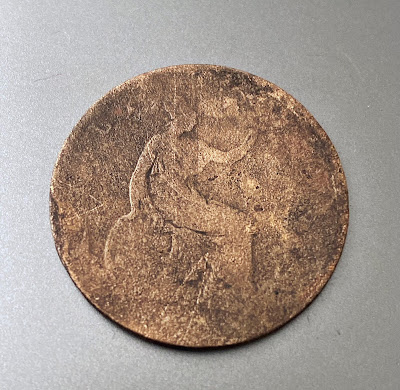Hunting in the shale and sand can produce some interesting results however I do find that all the lighter materials have a tendency to wash up closer to shore. In these specific areas you will find yourself getting loads of signals, most being tiny pieces of non-ferrous trash. I have a tendency to investigate any signal that I can rotate 360 degrees on, I'm looking for any fragment of the past however big or small. The piece of the Nuremberg Jetton below was a very small signal that could've easily been ignored. I actually found both pieces right next to each other. This demonstrates that it's important to dig all good signals. I've said it many times in the past "the more trash I dig, the luckier I get", this is very true when tackling the Thames foreshore. If you can get a 360 hit on it then dig it up, you wouldn't believe the amount of trash I've taken away from the river, it's amounted to a serious amount of metal which gets taken for recycling.


Other than fairly modern trash and recent drops you can still find some fantastic stuff in the shale, below is an old naval button that I dug, it was about 6' inches down. And the strange eagle ornament was found in the same area, it gave a very solid signal that I thought was going to be a large piece of iron. Once again this demonstrates the importance of digging everything that sounds good. On the Equinox 800 forget the VDI, I never look at the numbers, I have zero interest in them, I go on the tones every time, metal detecting is a tones game. I find the VDI to be utterly irrelevant, if you're going to base your decision on the numbers then you will be walking over good targets. The beauty of the Equinox is it's ability to provide a huge amount of information in the tones alone, my good friend has a Vanquish 440 and that to is a tones machine.


To stand the best chance of finding history on the foreshore you've got to get in the mud, a vast amount of great targets get trapped in it never really making their way any higher. The mud and clay builds up in certain areas creating little pockets that trap a lot of items, good holding areas can be found by simply looking where all the old metal and iron has gathered. Pay close attention to the patches that have lots of little screws and small metal items, these areas could be holding some fantastic artefacts, if there's small ferrous items there's a very high chance there's small non-ferrous items hidden in between and underneath.
If there are large pieces of metal and iron obscuring the surface I will clear as much of it up by hand putting it in a bag for recycling later. The Equinox doesn't cope great when you have loads of large iron pegs and nails on the surface, it can't see through them very well. That's where my Nexus V3 comes into play, with my 9' inch high frequency coil it can see non-ferrous targets through surface contamination easily. When smaller ferrous targets litter the surface I find the Equinox seems to do quite well and that's with running both the recovery speed and iron bias all the way up to 8 - if you can rotate 360 on the target, dig it up.

Obviously the Thames isn't just about finding metal objects, it's literally littered with pottery fragments, clay pipe pieces and an endless number of other interesting things, anything falling "into the above" gets collected and put in my pouch. In the fields when I use my Nexus machines I swing super slow, I like to really scan the ground listening carefully for the deep targets, on the Thames I will swing fast because I'm wanting to separate and isolate the signals, a slow recovery speed with a slow swing speed won't work that great because the targets will merge, there's so much stuff really close together. Not only that but I'm working with tide times so I want to try and recover as much as possible before the tide comes back in. All my finds have come from relatively small spots and I haven't ventured up into the heart of London yet, if you find holding areas, over time, they will replenish, this can happen relatively quickly depending on the weather and the tides, the secret is to keep hunting. It was only the other day that I went back to one of my regular spots and found a fantastic watch/clock winder, you just never know what might come up.

I haven't really got much more to add and I feel that I've covered the basics, it's no easy task hunting on the Thames foreshore but if you can master it then the rewards are there to be had, there's no "quick-fix" and you have to be prepared to put the time in, dig a lot of rubbish and potentially smell really bad. Taking detecting out of the equation, if like me you've lived in London a long time, the foreshore can offer a very unique perspective of the city. The Thames is a world within itself, it's the heart beat of London and when you walk its banks you feel a strange connection to the past, the city and the lost souls that use to live there. Modern day life is racing around up on the streets and the roads whilst for you time has slowed, you can hear the waves, the gulls flying overhead and the sweet language of your detector alerting you to a potential fragment of Londons past.
A Few More Finds
























Comments
Post a Comment